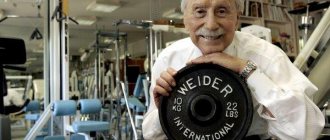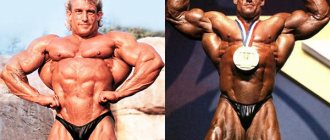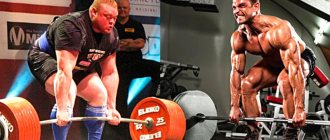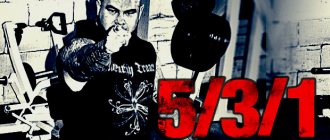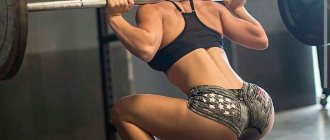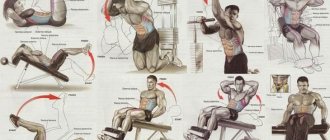“The Joe Weider system is considered the best of all invented in the history of bodybuilding. Having studied the Weider method, a novice athlete will be able to achieve the desired result in the shortest possible time and create muscles of the highest level.” These words, which are written in Joe Weider’s book: “The Body Building System,” are easy to believe, because the author wrote it, drawing information from his own experience, and his experience is 45 years of scientific and practical work, experiences and brilliant achievements. Many famous athletes and Arnold Schwarzenegger himself used Joe's knowledge to achieve their sports goals.
Introduction
In order to understand the very essence of strength training, you need to approach the explanation of this phenomenon almost from a scientific point of view. In any case, when talking about strength training through the prism of working with weights, we mean a very specific type of physical activity aimed at improving skills (exercise technique), improving skills (strength, flexibility, endurance) and expanding the physical capabilities of our body (muscle building ).
Strength training allows you to work your entire body. Workouts are usually divided by muscle groups, of which we identify only seven: legs, back, chest, deltoids, triceps, biceps, abs. Each group includes, on average, from 10 to 15 or 20 exercises, the purpose of which is to work them out qualitatively and comprehensively from different angles. And here we are gradually approaching today’s topic of presentation. One or another of Weider’s training principles, which were discussed in the title of the article, is applicable to literally each of these exercises.
ADVICE. On our website you can find both training programs, which will be discussed below, and directly seven large illustrated articles describing in detail the technique and tips for performing the exercises. You can go to specific articles using the links corresponding to the name of the muscle groups: legs, back, chest, deltoids, biceps, triceps, abs.
Truly, Weider’s principles in bodybuilding can be imagined as a kind of ecosystem in which all elements are interconnected and often not interchangeable, since each of them performs its own function and is important in itself, as one without which the normal existence and functioning of the whole the system as a whole is not complete.
ADVICE. Earlier, we have already described in detail the structure of the training process for men: beginner, advanced, experienced. So it is for women: beginner, advanced, experienced. This article serves as a logical addition to them, as an expansion of opportunities while maintaining the structure of the given training programs.
Childhood and youth
Joseph Edwin Joe Wider was born in the fall of 1919 in Montreal. The boy was raised in a Jewish family that previously lived in the Polish village of Kurov. He had a desire to go in for sports for a reason: in his youth he had a thin physique, and therefore often could not stand up for himself. When he was insulted again, Joe decided to end it and began intense training.
Joe Weider in his youth
Wider built his first training machine himself, finding an old locomotive axle and car wheels in a landfill. The boy made a barbell out of them, and soon other exercise equipment appeared at his disposal. In his youth, he quickly managed to achieve results; those around him noticed how thin and short Joe matured in a short time.
Load nature
As we know, basic exercises are the basis of strength training. All athletes, without exception, especially beginners, are recommended to build training programs around basic exercises. Shaping exercises are usually used when it is necessary to improve muscle symmetry, highlight their volume and emphasize their shape. Isolating exercises in the training program play an equally important, but still far from primary role, since they are not suitable for increasing body weight, but serve to target the muscles, reveal their relief and add striations. We described in more detail the specifics of these three types of exercises in our previous article “What are basic, formative and isolating exercises.”
We say this because Weider's principles apply to literally all training cycles and programs, including all known types of exercises, involving all muscles and even types of muscle fibers using loads of a completely different nature and acting from different angles, which ultimately forms the final result. This is why we need to understand not only the types of exercises, but also the types of load. And these indicators describe the nature of muscle contraction in the exercise.
- Dynamic load is a type of load in which the length of the working muscles changes and movement occurs in the joint. An exercise that involves movement of the body or its parts can be called dynamic.
- Static load is a type of load in which there is no change in the length of the working muscles and no movements are made in the joints. An exercise that involves a stationary position of the body or its parts is called static.
By and large, any exercise from the list of strength exercises that we described earlier in the relevant articles can be called dynamic. The most striking representative of static (or isometric) exercises is the press plank exercise. At the same time, in the plank you can perform movements with your body, arms and legs, and during the same bench press, you can hold the bar in a static position. In addition, earlier, when describing the technique of performing certain exercises, we also resorted to using the terms “positive” and “negative” phases of the exercise, which we will also talk about in the process of describing Weider’s training principles.
- The positive phase of the exercise is the moment of lifting the weight or the athlete’s own weight. The positive phase is usually performed with an effort that is accompanied, or after which you can exhale.
- The negative phase of the exercise is the moment of lowering the weight or the athlete’s own weight. The negative phase is usually performed with relaxation, which is accompanied by, or after which you can inhale.
Now, having understood the concepts of the nature of the load and the phases of the exercise, which will make it somewhat easier for us to understand the material, we can safely move on to studying the main topic. And first, let’s find out why the principles have this name.
Bibliography
- The Olympians: The Story of the Mr. Olympia Contest. — St. Martin's Press. — ISBN 978-0-312-58428-3.
- Joe Weider.
Bodybuilding, the Weider approach. — Contemporary Books. — ISBN 978-0-8092-5909-0. - Women's Weight Training and Bodybuilding Tips and Routines. - Contemporary Books, 1982. - ISBN 978-0-8092-5754-6.
- The Weider system of bodybuilding. — Contemporary Books. — ISBN 978-0-8092-5559-7.
- The Weider body book. — Contemporary Books. — ISBN 978-0-8092-5429-3.
- The Best of Joe Weider's Flex Nutrition and Training Programs. - McGraw-Hill, 1990. - ISBN 978-0-8092-4118-7.
- Joe Weider.
Joe Weider's Mr. Olympia Training Encyclopedia. - McGraw-Hill, 1991. - ISBN 978-0-8092-4040-1. - Joe Weider's ultimate bodybuilding: the master blaster's principles of training and nutrition. - Contemporary Books, 1999. - ISBN 978-0-8092-9775-7.
- Daniel Levesque.
The Weider Weight Training Log: Including a Daily Planner. — Hushion House. — ISBN 978-0-9684004-2-5. - [books.google.com/books?id=mlLLHqjA_ugC&pg=PP1 The Edge: Ben and Joe Weider's Guide to Ultimate Strength, Speed, and Stamina]. - Penguin, 2003. - ISBN 978-1-58333-144-6.
Origin of Vader's Principles
This concept hides the principles of planning and constructing the training process formulated by Joe Weider, one of the founding fathers of bodybuilding. Of course, he cannot be considered the inventor of all these principles. By right, he can only be considered the person who collected, classified and presented them to the general public, which he himself never hid. It was because of this that his name was associated with the principles outlined, which were called in his honor “Joe Weider’s Training Principles”, or simply “Weider’s Principles”.
There are quite a few of these principles, 35 in total. However, we have collected them all in one article so that you can familiarize yourself with them. Of course, it will be quite difficult for an unprepared person to master such a significant amount of information, however, we tried to first arrange it in the form of a table as a visual aid, and then describe in detail each of the given points in the most accessible language.
As you can see in the diagram above, Joe Weider’s training principles, according to the accepted classification, are divided into three large blocks: principles of cycle planning, principles of training design and principles of exercise execution. Well, without further ado, let’s move on directly to studying them.
Preface about the author of the program
Joe Weider is a truly iconic figure in modern bodybuilding. Perhaps he can be put on a par with such athletes (whom he trained) as Arnold Schwarzenegger, Frank Zane, Larry Scott, although he did not achieve significant success in “iron sports” as an athlete, but was a leading businessman developing the topic of bodybuilding in USA.
Joe Weider was born in 1929 in Canada and began training at an early age. After the Second World War, Joe, together with his brother Ben (by the way, the Ben Weider College of Bodybuilding in St. Petersburg is named after Ben) begins to actively promote bodybuilding to the masses. In 1946, the brothers founded the International Federation of Bodybuilders (IFBB), and 19 years later their main “brainchild” was born - the Mr. Olympia competition.
Since 1981, Weider founded his own publishing house, Weider Publications, which published world-famous magazines: Shape, Flex, Muscle Power, Mr America, Men's Fitness, Living Fit, Prime Health and Fitness, Fit Pregnancy, Cooks and Senior Golfer.
Vader is the author of the book series: “The Joe Weider Body Building System.”
Principles of cycle planning according to Weider
The principle of macroperiods. It involves dividing the training cycle into periods. Take it as a period of time – a year. Divide the year into strength (3 months), mass building (4 months), functional training (3 months) and definition work (2 months). Combine segments in duration and order of presentation depending on their priority and goals. This will give your body the most versatile development possible.
The principle of microperiods. This principle involves planning the training process within one month. Most often, weeks are planned in this way: heavy - light - heavy - light, or heavy - heavy - light - light. The first example is best suited for men, and was described by us in the corresponding article. The second example, due to physiological characteristics, is best suited for women, as we wrote about here.
Split principle. This Weider principle involves dividing the training week into days for the upper and lower body. If you train twice a week, train your chest and back on one day, and legs on the other day. A three-day week involves training chest/biceps on one day, back/triceps on the second day, and legs on the third day. This approach is considered the most popular among most athletes due to its high effectiveness.
Crushing principle. It involves dividing one large workout into two or three shorter, but more intense ones. If you train chest/biceps on one day and such a workout takes an hour, you can train a larger muscle group (chest) in the first half of the day, and a smaller muscle group (biceps) in the afternoon. This will allow each individual workout to be carried out more intensively, efficiently and with less time wasted.
The principle of surprise. Performing the same exercises for a long time reduces the “muscle response” and causes addiction to a uniform load, which leads to stagnation in training. This principle of Joe Weider suggests constantly surprising the muscles with an unusual load, that is, not letting them get used to it and exposing them to different exercises, with different weights at different angles. This will greatly boost muscle growth and results.
The principle of overload. For stable and systematic growth of both strength indicators and muscle mass, it is necessary to systematically increase working weights. Increase the weight of the working equipment, giving the muscles a new, greater load than before. By increasing training stress, firstly, you will not allow the muscles to get used to a uniform load and go into stagnation, and secondly, increasing weights is the fundamental principle of muscle building.
The principle of volume. Muscles are made up of different types of fibers: fast and slow, each of which responds to training load differently. This principle of Weider's training involves uniform training of both types of muscle fibers through the use of different approaches to performing exercises, the number of approaches and repetitions, varying the frequency of training and the degree of their intensity, which improves the quality of training.
The principle of diversity. It is also called the principle of eclecticism. It involves a constant alternation of basic, formative and isolation exercises (which we talked about here). This variety allows, according to the principle of surprise, to prevent the muscles from getting used to one order of performing exercises, which should also be changed periodically. From time to time, rearrange the types of exercises in your program.
The principle of instinct. Instinctive training involves constant experimentation with your approach to the training process as a whole. Its task is to evaluate the results of certain changes or innovations in training, in order to further conclude how effective this or that approach, principle or method is for you. This Weider training principle involves listening to your body and learning to understand what works for you and what doesn't.
Nutrition
Whatever sport you choose, 60% of success will depend on proper nutrition. Here are three basic rules that must be followed according to Joe Weider :
- It is necessary to carefully monitor the quality of food consumed . It is important that the diet includes all the main components.
- Properly distribute your calorie sources : 60% - carbohydrates . Moreover, it is advisable to eat natural carbohydrates. They give our body the necessary energy that maintains our vitality throughout the day. They are also necessary for restoring glycogen in muscles. 20-25% – plant and animal proteins (preferably with less fat). Protein is needed to produce energy and repair muscle fibers that are stretched during training, and also allows you to build muscle mass faster. 25-30% - fats. They maintain normal blood viscosity. In addition, they promote the production of hormones and the supply of vitamins and energy. In addition to all of the above, in between meals, you need to eat a portion of vegetables and fruits, and also drink 2-3 liters of water per day .
- Nutrition should suit your body type . Beginners need to reduce the amount of fat and, conversely, increase their protein intake.
We discussed this in more detail in the following articles:
- Fitness and nutrition;
- Metabolism;
- What you need and healthier to eat for breakfast;
- All about calories.
Principles of training according to Weider
Base principle. According to this principle, the entire workout is based exclusively on basic exercises and a selected muscle group. For example, chest training based on this principle is based primarily on barbell presses and dumbbell presses lying on a horizontal bench. This type of training is recommended primarily for beginners. It is used during the period of active muscle mass gain in order to quickly increase overall body volume.
The principle of form. According to this principle, the entire workout is built exclusively on formative exercises for the selected muscle group. For example, back training based on this principle is based mostly on variations of vertical block rows and one-arm dumbbell rows. This type of training is recommended for advanced athletes. It is used during the period when the mass that has already been gained needs to be shaped and volume added.
The principle of isolation. According to this principle, the entire workout is built exclusively on isolation exercises for a given muscle group. For example, leg training according to this principle is based mostly on leg extensions and bends, as well as calf raises. This type of training is recommended for experienced athletes. It is used during preparation for competitions, to reveal relief, separate muscles and give them clear contours.
The principle of division. This Joe Weider principle suggests dividing training separately into flexor muscles and separately into extensor muscles. According to him, training, for example, arms can be divided into two workouts or even two days. One day you train your biceps, another day you train your triceps. It’s the same with legs - one day you train the front part of the thigh (quadriceps), the other day the back part (femoral biceps). This gives the muscles more training stress.
The principle of sets. A set is one approach in a specific exercise. Previously, it was customary to perform only one approach in each individual exercise. This approach is outdated, and the modern set principle involves performing several approaches in one exercise. By performing many sets of one specific exercise (more than 3), you get more muscle stress, which significantly accelerates their growth.
The principle of supersets. According to Weider's training principles, a superset consists of two exercises for antagonist muscles (flexors - extensors), combined into one, one approach each. So, you have the right to do a set of barbell curls, then immediately do a set of French presses and only then take a break. Two approaches to antagonist muscles without a break is one superset. Such approaches can be done from 1 to 3, 5 or more.
The principle of the complex. This principle, by analogy with the previous one, consists in combining two approaches into one large one, but only with the participation of synergistic muscles (extensors - extensors). For example, you could do a set of barbell squats, followed by a set of leg presses, and only then take a break. Two approaches of different exercises for synergistic muscles without a break - this is one comprehensive approach. You can do them as many times as you like.
Triset principle. This Joe Weider principle involves combining three exercises into one, one approach for each. Such a triset is made up of exercises for one muscle group. Using the example of chest training, this could be a bench press + dumbbell bench press + chest press in a machine. Moreover, it is not necessary that these are only bench press or only traction exercises. You can combine exercises in a triset as you wish.
The Giant's Principle. A so-called giant set can include 4 or more exercises, one approach for each. This way, you combine several small ones into one big approach. A giant set can be composed of both synergistic and antagonistic muscles. Using the example of training biceps and triceps, you perform the first and third exercises for biceps (with a barbell and dumbbells), the second and fourth for triceps (with the same equipment).
The principle of alternation. This principle of Joe Weider suggests that between approaches to larger muscle groups (legs, back, chest), perform approaches to smaller ones (deltoids, triceps, biceps or calves, trapezius, forearms, abs). For example, in leg training, you can do abdominal exercises between sets. Alternate squat sets with press sets, and so on in turn. But not in a row, but with rest, otherwise it will be supersets.
The principle of respite. Perform 2-3 repetitions with your maximum working weight for a specific exercise. Then take a short rest, about 30 seconds, then 2-3 repetitions and rest again. And so on until you reach the required number of repetitions for this exercise according to the training program. This will give the muscles a new, completely different type of training stress, which will further spur them to grow.
The principle of priority. According to this Weider training principle, when training a specific muscle group, the muscles lagging behind in development are trained first. If we consider shoulder training under the prism of poorly developed rear deltoids, then it is with their pumping that you need to start training in order to give your best while you are still full of strength. This principle allows you to align lagging muscles, muscle groups or individual bundles and sections of them in development.
The principle of fatigue. It involves performing formative or isolating exercises for the selected muscle group before performing heavy basic exercises. This approach to building a workout makes it possible to pre-heat and pump up blood, that is, to prepare for work those muscles, muscle groups, or their individual bundles and sections that cannot be “reached” in the basic exercise. We talked about this in the corresponding article.
The pyramid principle. Start training with light weights and then increase them until you reach your working weight for the specified number of repetitions. If, for example, in a deadlift your working weight for 8 reps is 100 kg, start the exercise with an empty bar (20 kg) for 16 reps, then 40 kg for 14 reps, 60 kg for 12, 80 kg for 10 and finally 100 kg by 8. This will prepare you to work with heavy weights and at the same time warm up the muscles and fill them with blood.
The principle of drop sets. Finish the exercise by gradually losing weight. It's kind of a reverse pyramid. For example, in the bench press your working weight for 8 repetitions is 100 kg. Having completed the specified number of approaches, perform the last one without rest, as follows. 100 kg for 8 reps, immediately drop the plates from the bar, 80 kg for 10, then 60 kg for 12, then 40 kg for 14 and finally 20 kg for 16 reps. All this is done in one go, without interruption.
TRAINING PRINCIPLES FOR THE MOST EXPERIENCED
The principle of "cheating".
“Cheating” should not be considered as a way to relieve stress from a muscle, but as a means of increasing it. The whole point of athleticism is to make your muscles work more, not less. Therefore, you should only use cheating to perform additional repetitions or to help the working muscles by recruiting muscles from another part of the body. Let's say you're doing a concentration curl on a cable system and you're unable to complete the last two or three reps. If you use your free hand to help the training arm to "finish" a couple of extra reps, this is a smart use of Weider's training principle called "cheating." If you lift your pelvis off the bench in an effort to get a couple extra reps on the bench press, this is an unwise use of the "cheating" training principle. The first option increases the load on the muscle, the second reduces it.
Triset principle.
When you perform three exercises to develop the same muscle group without resting between sets, you are doing a triset. This technique allows you to quickly pump up your muscles. Since you're attacking them from three different angles, this becomes the muscle shaping technique of choice. Trisets develop local factors for restoring muscle endurance and as such are an excellent technique for increasing vascularity.
The principle of the giant approach.
A giant set is a set of 4-6 exercises for the same muscle group with little or no rest. Let's say you intend to train your chest muscles. Perhaps you do bench presses, incline presses, dips, and pullovers. You do a flat bench press, rest for 30 seconds, an incline press followed by a 30-second rest, a dip followed by a 30-second rest, and a pullover with a 30-second rest. This is one giant approach. By performing approaches in this way and repeating this procedure 3-4 times, you will be able to perform each exercise that works a separate part of the muscle with full effort. This will ensure balanced development of your pectoral muscles.
Principles of performing Weider exercises
The principle of quality. This Weider principle encourages you to gradually reduce the rest time between sets and at the same time increase the intensity of the exercise through increasing the number of repetitions. This principle significantly increases the intensity of training, which in turn enhances the spread of nervous stimulation from the brain to the spinal cord, which ultimately initiates a greater release of hormones than with less intense training.
The principle of cheating. In this case, cheating involves some kind of deception, the essence of which boils down to the following. At the end of the approach, when you have already brought your muscles almost to failure and you do not have enough strength to perform the repetition technically correctly, you are allowed to slightly violate the technique and “throw” the projectile or body by inertia. The disadvantage of this approach is that it violates technology. The advantage is that you can put extreme stress on your muscles, crossing the point of failure.
The principle of tension. To keep the maximum number of muscle fibers involved in the work, leave tension in the muscles all the time. By fully extending your arms until your elbows lock or your legs until your knees lock, you remove the load from the muscles and transfer it to the joints. Compliance with this Weider principle requires uniform distribution of the load over the entire amplitude of movement of the projectile or the athlete’s body, without jerking or swinging due to inertia.
The principle of forcing. This principle involves having a partner who will help you overcome rejection at a time when your strength is running low. In other words, using the bench press as an example, this is a spotter whose task is not just to protect you from the barbell falling on your chest, neck or face, but to help you do one, two or more additional repetitions to put maximum training stress on the muscles.
Tide principle. According to this Joe Weider principle, before you begin to train a specific muscle group (for example, flexors), it is recommended to perform several sets of antagonist muscles (extensors). For example, before you start training your biceps, you can do several sets of triceps exercises. This approach will give you an indirect rush of blood into the muscle or muscle group that you plan to train.
The principle of burning. This principle suggests at the end of each individual approach, at the moment of exhaustion of energy resources in the trained muscle or muscle group, to perform final repetitions in partial amplitude. Using the bench press as an example, when you feel that you no longer have enough strength to press the barbell all the way to the top point, do not place it on the racks, but perform the remaining repetitions provided for in the program, bringing the muscles to a burning sensation.
Half-phase principle. This Weider training principle suggests performing the exercise in a selected range of amplitude, performing the lifting or lowering phase only partially. Such an unusual load will make it possible to pump those areas and sections of muscles that cannot be involved in work at full amplitude. The amplitude can be upper (not full extension/lowering), lower (not full flexion/raising) and middle (both at the same time).
The principle of negativity. The lowering phase of the weight, or as it is also called the “negative phase,” is better able to stimulate muscle growth than the positive phase (lifting). This is due to the fact that during the lowering phase you are able to work with a weight that is 30-40% higher than during the lifting phase. It is recommended to perform “negatives” twice as slow as “positives”. Using pull-ups as an example, you go up for 2-3 seconds, and go down for 4-6 seconds.
Peak principle. This training principle of Joe Weider involves adding a moment of peak contraction to the exercise, when at the top point you do not immediately return to the starting position, but linger for a few seconds and strain the working muscles even more. Using the information in the “butterfly” simulator as an example, at the moment your hands touch in front of you, stay in this position for 2-3 seconds and squeeze your hands even more.
The principle of speed. It involves performing exercises at an accelerated pace, which helps stimulate the development of fast muscle fibers. This method of muscle training allows you to develop maximum muscle strength and power. This is realized due to the fact that the fast type of muscle fibers is best suited to perform short-term but powerful work. Include “quick” sets in your workout to hit this fiber type hard.
The principle of isometry. This principle of isometric contraction involves holding the muscles under tension without any weights for a certain period of time. As a rule, the duration of one approach is about 10 seconds; in total, it is recommended to perform from 30 to 45 such approaches. According to studies, isometric load with systematic exercise can increase strength indicators by 5% within 10 weeks.
Training principles
- System of several approaches. This system is performed with each exercise in order to completely exhaust the muscle (group of muscles) being trained, as well as to ensure their stimulation and maximum development.
- The principle of shocking muscles. You should never allow your muscles to adapt to a training program. In order for muscles to grow, they need to be kept under constant stress. Therefore, it is necessary to change the number of approaches and repetitions.
- The principle of muscle isolation. Muscles can work in isolation from each other. If you want to develop a specific muscle, you need to isolate it from other muscles. This can be achieved using an anatomical position.
- The principle of priority. Give priority to your weakest muscle and start training it first in each session while your energy is at its maximum.
- The "pyramid" principle. You should not start working with heavy weights. The work should start with a small weight, and then go to increase it. Start your workout with a weight of 50% of your maximum and complete the exercise for 15 repetitions. Then increase the weight and do 10-12 repetitions. So increase the weight of the weights to 80%, and repeat the exercises 5-6 times.
- The principle of constructing training cycles. At the initial stage, you prepare a training program and build muscle tissue. At the next stage, it is necessary to increase the number of repetitions and reduce pauses between approaches.
- The principle of "cheating". “Cheating” is not considered as a way to relieve stress from a muscle, but rather to increase it. Therefore, this technique should be used to perform additional repetitions or to help the working muscles by recruiting muscles from another part of the body.
- The "rest-pause" principle. If the weight of your weights is so heavy that you cannot perform more than two or three repetitions, you need to rest your muscles for 30-45 seconds and do a few more repetitions.
- The principle of double division. Most athletes train one or two body parts in the morning and then return to the gym in the afternoon or evening to work a couple more muscles.
These are just a few of Joe Wade's most commonly used training principles.
Weider's training principles.
- System of several approaches. This system is performed with each exercise in order to completely exhaust the muscle (group of muscles) being trained, as well as to ensure their stimulation and maximum development.
- The principle of shocking muscles. You should never allow your muscles to adapt to a training program. In order for muscles to grow, they need to be kept under constant stress. Therefore, it is necessary to change the number of approaches and repetitions.
- The principle of muscle isolation. Muscles can work in isolation from each other. If you want to develop a specific muscle, you need to isolate it from other muscles. This can be achieved using an anatomical position.
- The principle of priority. Give priority to your weakest muscle and start training it first in each session while your energy is at its maximum.
- The "pyramid" principle. You should not start working with heavy weights. The work should start with a small weight, and then go to increase it. Start your workout with a weight of 50% of your maximum and complete the exercise for 15 repetitions. Then increase the weight and do 10-12 repetitions. So increase the weight of the weights to 80%, and repeat the exercises 5-6 times.
- The principle of constructing training cycles. At the initial stage, you prepare a training program and build muscle tissue. At the next stage, it is necessary to increase the number of repetitions and reduce pauses between approaches.
- The principle of "cheating". “Cheating” is not considered as a way to relieve stress from a muscle, but rather to increase it. Therefore, this technique should be used to perform additional repetitions or to help the working muscles by recruiting muscles from another part of the body.
- The "rest-pause" principle. If the weight of your weights is so heavy that you cannot perform more than two or three repetitions, you need to rest your muscles for 30-45 seconds and do a few more repetitions.
- The principle of double division. Most athletes train one or two body parts in the morning and then return to the gym in the afternoon or evening to work a couple more muscles.
TRAINING PRINCIPLES FOR PERSONS WITH INTERMEDIATE EXPERIENCE
The principle of priority.
Train the weakest part of your body first in each session while your energy is at its highest. For example, if your shoulder muscles are weak, you should perform barbell or dumbbell overhead presses, chin rows, and lateral raises first, and then any bench presses. Due to this, you will achieve maximum intensity of training for the muscles of the shoulder girdle, giving these exercises priority.
The "pyramid" principle.
Muscle fibers grow under the influence of powerful weights and at the same time increase strength by contracting when overcoming the weight of resistance. If you could theoretically lift a maximum weight for eight repetitions without warming up and perform a certain number of approaches, this would be a very effective technique for developing volume and strength. But you won’t do this, since training with maximum weights and even without a warm-up will inevitably lead to serious injury. Nobody starts out by lifting as much weight as possible.
The pyramid system is designed to get around this problem. Start your workout with a weight of 60% of your maximum and perform the exercise with this relatively light weight for 15 repetitions. Then increase the weight and reduce the number of repetitions to 10-12. Continue increasing the weight until it reaches approximately 80% of your maximum and perform 5-6 reps. Now that you've warmed up, you can lift heavy weights and reap the rewards of your work without fear of injury.
The principle of separate training.
After a three-month period of training on a three-times-a-week schedule, you may want to increase your overall training intensity. If you divide your body into upper and lower halves, you can include more exercises and more sets to train each half more intensely. According to my split training system, in the first lesson of the week you perform eight exercises aimed at developing only the upper half of the body. Since you're only working the upper portion, you'll perform all eight exercises at super intensity because your energy levels are high. The next day, concentrate your efforts on the lower body, performing 6-8 exercises on its muscles at the same intensity. With the three-day weekly regimen, you were forced to work both halves of the body—upper and lower—on the same day. Naturally, the intensity of the three-day regimen was low. With a separate technique, you can work each part of the body harder and longer, and that is why you will develop more symmetrical, more voluminous and better formed muscles.
Only by building training cycles will you be able to train long enough to reach your full potential without exhausting yourself or overtraining.
The principle of filling (“flushing”).
By applying weights, you cause blood flow to a particular muscle and hold it there in order to cause muscle fiber growth. As an example: when you train your chest muscles by performing 3-4 exercises that affect only this part of the body, you use the principle of filling your pectoral muscles with blood.
Training plan: day two
Wednesday exercises include:
- Bench press in a horizontal position. The grip is wide.
- Alternating dumbbell bicep curls while seated.
- Alternating French press with dumbbells in a seated position.
- Exercise for the neck: put your hands on the back of your head, pull your head back, overcoming the resistance of your hands.
- Broaching with a barbell. The grip is narrow.
- Lifting the barbell in front of you with straight arms in a standing position.
- Barbell lifts with a straight forearm grip.
- Rowing a barbell to the chest while standing bent over with a wide grip.
- Shrugs with a barbell.
- Squats.
- Hackenschmidt squats
- Calf raises with a dumbbell in hand using an elevated platform.
- Bend to the sides with a weight in your hand.
- Raising the body in a lying position.
Thursday is a day of rest.
Body-building
As soon as the young man acquired relief forms, people began to wonder how he managed to achieve this. Then Wider came up with the idea of presenting his knowledge in a magazine. At the age of 17, he published the first publication containing information on proper muscle building and a training program. 50 thousand copies flew out of the newsstands in a month, at first it was a small brochure called Your Physique, over time it grew into a serious Muscle Builder magazine, then it was renamed Muscle & Fitness.
By that time, the bodybuilder had thoroughly studied the principles of training to build muscle mass, and therefore decided to write the first book in his biography, “The Joe Weider Body Building System,” which became a guide for professionals and beginners in creating sculpted muscles. His body was living proof that putting these tips into practice can produce great results. With a height of 178 cm, he managed to gain weight up to 96 kg (in the off-season he dropped to 85 kg), and his biceps had an impressive volume, while the man remained pumped up, which is clearly visible in numerous photos.
Joe Weider and Arnold Schwarzenegger
Joe was not alone in promoting bodybuilding; his brother Ben Weider helped him in this, with whom he created the International Federation of Bodybuilders in Canada. And together with it he subsequently released another publication, “Bodybuilding from the Widers.” Then the athlete wrote more than one book, for example, “Bodybuilding. Fundamental course", or Mr. Olympia Training Encyclopedia.
At that time, the best bodybuilders participated in the “Mr. Universe”, and the only disadvantage of this event was that the winners were forbidden to participate again in similar competitions. To encourage athletes to continue training, Joe founded the Mr. Olympia competition, in which participants could continue to earn money by performing. And then he and his wife created a company developing sports nutrition; the Wider brand is still popular today.
During his career, Wider was involved not only in organizational matters, the man also worked as a coach. Over the years, the bodybuilder trained with Louis Ferrigno, Arnold Schwarzenegger, Lee Haney, Frank Zaney and many other bodybuilders who made excellent careers in the sport.
Training plan: day three
On Friday you need to perform the following complex:
- Bench press in a horizontal position. The grip is average.
- French press with a barbell.
- Barbell curls for biceps.
- Alternating triceps raises while standing on an incline.
- Army press.
- Raising the barbell to the chest.
- Dumbbell row for the latissimus muscle.
- Leg raises with weights in a lying position.
- Body bends with a dumbbell behind your head in a standing position.
- Exercise for the neck: put your hands on the back of your head, pull your head back, overcoming the resistance of your hands.
- Lifting the barbell for biceps with a straight grip.
- Front squats with a barbell.
- Walking on your toes with a barbell on your shoulders.
Saturday and Sunday – the athlete rests.

